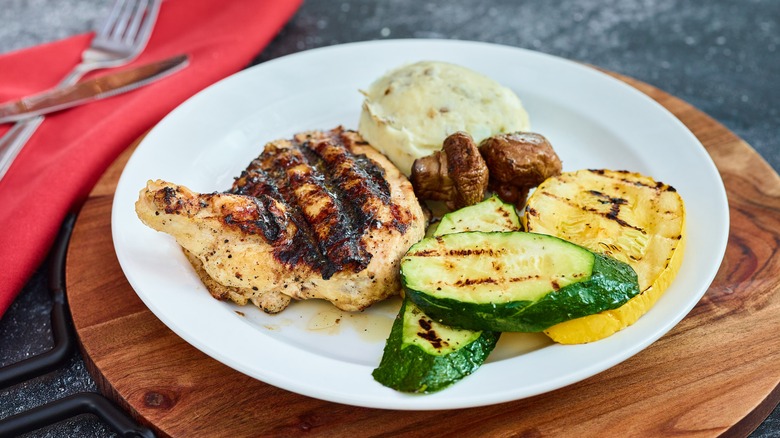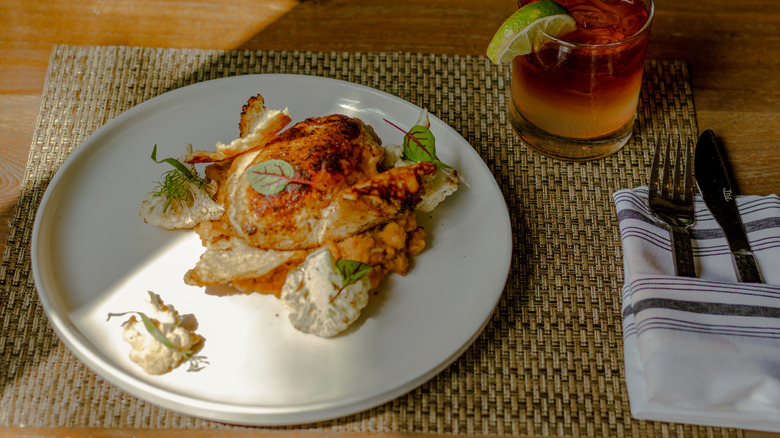Cutting An Airline Chicken Breast Correctly Is A One-Way Ticket To Juicy Meat
If you're not already familiar with airline chicken breast, its name probably doesn't sound appealing. Airplane food is terrible, right? While the name is connected to air travel (more on that in a moment) airline chicken breast actually refers to a chicken breast with the first joint of the wing still attached to it. If you've ever made buffalo chicken wings or similar, you know that a chicken's wing is divided into three portions: the drumette, the flat, and the wing tip, the last of which is typically discarded. The extra joint on an airline chicken breast corresponds to the drumette, so you're getting a chicken breast and wing at the same time.
Airline chicken breasts may also be referred to as Frenched breasts, Statler chicken, or chicken suprême. No one's completely certain how it became known as airline chicken. One theory suggests that during the early days of commercial air travel when airlines offered free meals to passengers (ah, the good old days), chefs would leave some of the bone attached so that the serving would appear bigger. Another story says that leaving the bone on the breast provided a convenient handle for passengers to grip as they ate. The simplest theory says that people started calling it an airline chicken breast when they noticed the protruding joint looked like the wing of a plane. Whatever the name's origins, this might be the juiciest chicken breast you ever taste.
How to butcher your own airline chicken breast
It can be difficult to get your hands on an airline chicken breast because it's not a standard cut. Some specialty butchers might offer them, but it's more likely that you'll have to call in advance and request them to prepare airline chicken breasts for you. This will inevitably run up the price a bit (airline chicken breasts run around $8-$12 per pound), but there's a cheaper way to go. By butchering a whole chicken on your own, you can get airline chicken breasts plus a whole lot more.
To cut your own airline chicken breast, start with a whole chicken and a really, really sharp knife. Lift up one of the chicken's wings, stretching it to its full length, and cut through the skin around the drumette. It's best to do this by holding your knife still and rotating the bird for a clean, circular cut. After that, you can grab the flat of the wing and bend it backwards, snapping the wing at the joint. The flat will pop right off, and you'll have a clean bone beneath.
Proceed by slicing the breast meat off of the breast bone as you would when butchering a typical chicken breast. Once you have your airline chicken, you can use the rest of the bird for whatever you want, and save the bones to make chicken stock.
What makes an airline chicken breast so juicy?
Chicken breasts often get a bad rap for being dry, but this is only really a problem for boneless breasts. Chicken bones contain plenty of fat, and fat is the key to moist, flavorful meat. When you remove all of the bones from a chicken breast, you lose almost all of its succulent fat. Furthermore, the bone helps to regulate heat flow within the meat as you cook. This does mean that bone-in chicken can take longer to cook, but the end product is going to be juicier.
Chicken skin, too, is an important source of fat. If you cook an airline chicken breast with the skin on, the fat beneath the skin melts into the meat to add extra moisture and a new dimension of flavor on top. As a bonus, the skin turns golden and crispy, becoming a delicious treat in and of itself.
There's one more thing that makes airline chicken breasts special beyond their juiciness. The protruding bone is indeed sturdy enough to use as a handle, which means you can turn a whole chicken breast into a convenient finger food. Plus, it looks unique, making the presentation of your dish more memorable.


